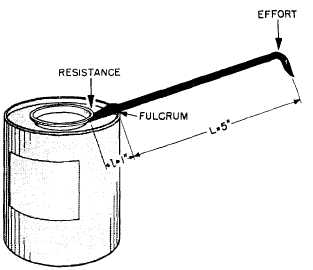Here is a sign of a direct relationship between the length
of the lever arm and the force acting on that arm.
You can state this relationship in general terms by
saying: the length of the effort arm is the same number
of times greater than the length of the resistance arm as
the resistance to be overcome is greater than the effort
you must apply. Writing these words as a mathematical
equation, we have
where
L = length of effort arm,
l = length of resistance arm,
R = resistance weight or force, and
E = effort force.
Remember that all distances must be in the same
units, such as feet, and that all forces must be in the same
units, such as pounds.
Now let’s take another problem and see how it
works out. Suppose you want to pry up the lid of a paint
can (fig. 1-8) with a 6-inch file scraper, and you know
that the average force holding the lid is 50 pounds. If the
distance from the edge of the paint can to the edge of the
cover is 1 inch, what force will you have to apply on the
end of the file scraper?
According to the formula,
here,
L = 5 inches
l = 1 inch
R = 50 pounds, and
E is unknown.
Then, substituting the numbers in their proper places,
we have
and
E=soxl
5
= 10 pounds
You will need to apply a force of only 10 pounds.
Figure 1-8.-A first-class job.
The same general formula applies for the second
class of levers; but you must be careful to measure the
proper lengths of the effort arm and the resistance arm.
Looking back at the wheelbarrow problem, assume that
the length of the handles from the axle of the
wheel—which is the fulcrum-to the grip is 4 feet. How
long is the effort arm? You’re right, it’s 4 feet. If the
center of the load of sand is 1 foot from the axle, then
the length of the resistance arm is 1 foot.
By substituting in the formula,
and
E = 50 pounds.
Now for the third-class lever. With one hand, you
lift a projectile weighing approximately 10 pounds. If
your biceps muscle attaches to your forearm 1 inch
below your elbow and the distance from the elbow to
the palm of your hand is 18 inches, what pull must your
muscle exert to hold the projectile and flex your arm at
the elbow?
By substituting in the formula,
1-4



